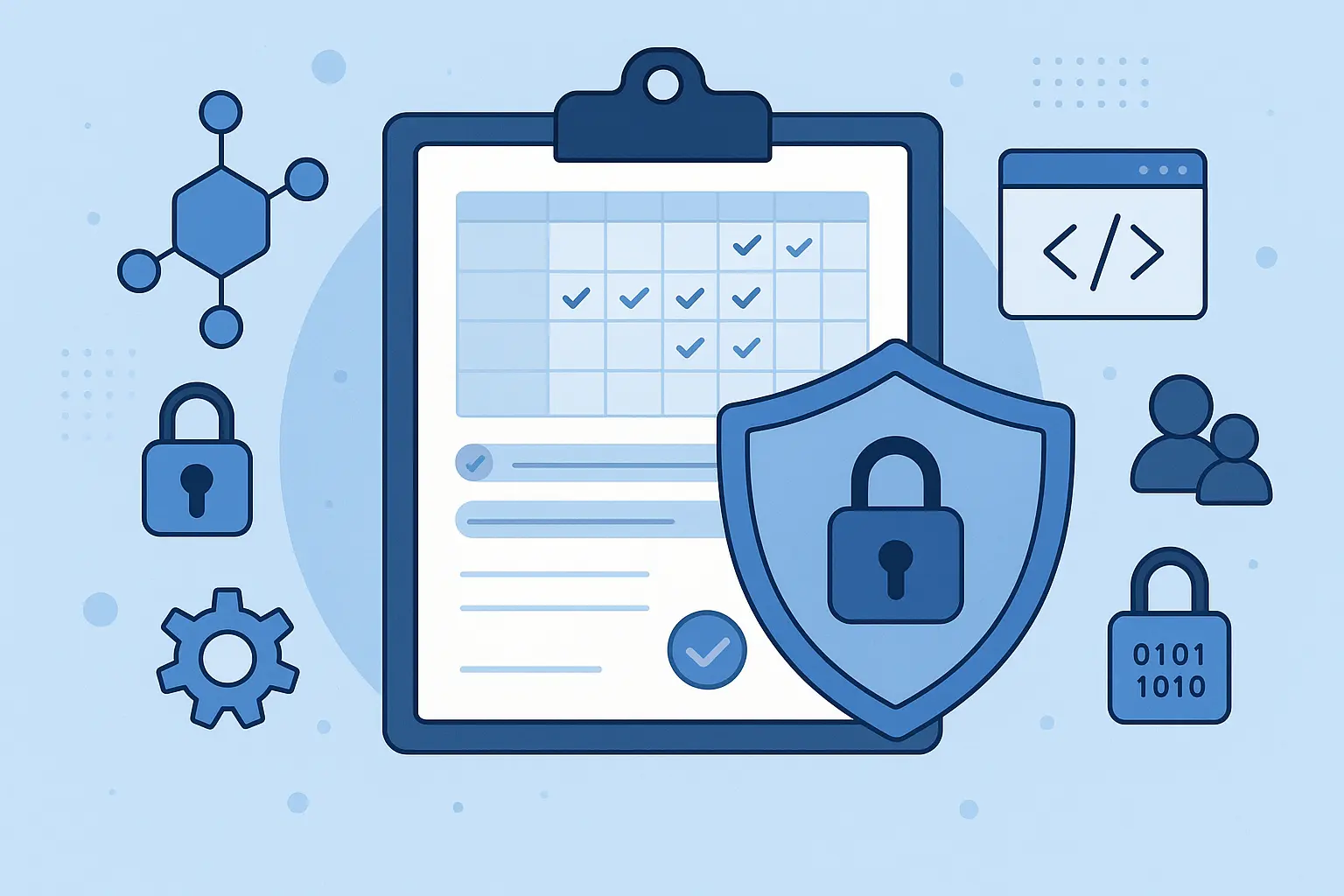Your organization is like a finely tuned machine where systems work together in harmony to keep things moving on track. Application Programming Interfaces (APIs) are the unseen interfaces that connect these systems with each other. For service organizations that support appointment-time bookings, APIs run constantly in the background, executing critical processes and exchanging sensitive data.
Every time a customer books, reschedules, or pays for an appointment, APIs connect your booking system to calendars, payment gateways, and other web applications. These API requests are definitely necessary, but they also introduce security risks. Without proper API security, your business is at risk of security breaches, service interruptions, and loss of client trust.
Securing your API need not be complicated. As you begin to digest these concepts and assess your current security controls, you can enforce security effortlessly. Here are all the best practices that can help you build a strong, secure, trustworthy business.
Why API Security Matters
When a customer books an appointment, they are trusting you with more than just their time. They are giving you personal information, such as names, email addresses, and phone numbers, and may even share payment information. Your scheduling system is responsible for managing the sensitive data provided by your customers, and APIs push this information throughout your systems.
For example, an API gateway could connect your website with your scheduling software, which would then update your calendar, send an appointment confirmation email, or process payments. If connections are not secure, an attacker could find a way in. Your business requires solid API security controls to protect customer data, keep your services running, and safeguard your reputation.
Listed are tangible steps you can implement to help secure your web APIs.
1. Implement Strong Authentication for Every API Request
Authentication is the gatekeeper for your APIs. You need to validate the identities of each user and application accessing your system. Weak or basic authentication mechanisms are a lousy practice akin to leaving your front door unlocked.
OAuth 2.0 allows an application to access your APIs on behalf of a user while protecting the user’s authentication. API Keys are scoped and attached to particular functionality, so do not provide a single API with access to everything in your system. Each application or web service should have an API key, with its access scoped to only its functionality. If the key is compromised, you can revoke access only to that key and not the rest of the system.
Access tokens should be short-lived to limit the time window attackers have to exploit them. Regularly rotate access tokens and keys. Require multi-factor authentication for administrative actions or access to sensitive scheduling data to reduce unauthorized access further.
2. Enforce Authorization at the Object Level
After a user is authenticated, you still need to control what actions they can take. Authorization is the act of setting and enforcing these permissions. Knowing who is making the request isn’t enough; you’ll also want to ensure they are authorized to access or modify the specific data they’re requesting.
Object-level access control is an important concept in API security. This means you should verify that the user is authorized to access the specific object (e.g., a specific appointment or customer record) for each request. Otherwise, a user could access another user’s data by simply changing an ID in an API request.
In addition to object-level control, you should also enforce authorization at the function level. For example, a regular user might be able to view their own appointments, but an admin-type user should be able to delete them. You should never trust the client-side (e.g., the user’s browser or mobile app) to enforce authorization. All authorization must take place at the server, where it clearly cannot be skipped.
3. Validate and Sanitize All Input Data
Always assume that any data entering your API will cause harm. Input validation verifies that all data is in the expected format, type, and length. Sanitization cleans the data of any dangerous characters or code.
Establish an exact schema for your API requests and reject anything that does not conform to it. This will help prevent a wide variety of attacks, including injection attacks, and help alleviate bad data formats that will bring down your entire system. When validating, it’s easier to define what is allowed than to block what’s most dangerous explicitly. It is nearly impossible to anticipate every way a user could misuse a site, so an allowlist is much more secure.
When dealing with databases specifically, always use parameterized queries (or prepared statements, to some) so user input cannot be treated as executable code. This is considered one of the best practices for preventing SQL injection attacks. Just like you should do input validation, you should also encode output. This is especially a concern with an API if its data is displayed in a web browser; you risk a serious Cross-Site Scripting (XSS) attack.
4. Implement Rate Limiting and Throttling
Rate limiting and throttling are important security measures that help protect against denial-of-service attacks and API abuse. Essentially, they provide a way to control how many requests a user or application can emit within a specific timeframe.
Establish tiered rate limits that vary by user type. For instance, a user paying for your service may be allowed to make more requests than a user on a free plan. It is also worth noting that not all API endpoints are created equal, and thus, a resource-intensive API will likely warrant tighter restrictions than a less intensive one.
If a user exceeds their rate limit, avoid simply blocking them. Instead, apply the rate limit and return an HTTP 429, or “too many requests,” response, as the better user experience. It’s better for a legitimate user to receive a rate limit response to slow down than for your API to simply block them. If you’re feeling adventurous, you can even provide a more robust form of protection with dynamic throttling and proactively tighten the throttle for users that it detects as possibly engaging in bad behavior.
5. Encrypt Data in Transit and at Rest
Be sure to consider encryption an essential part of your API protection strategy so that, in the event someone compromises data in transit or at rest, it remains unreadable to unauthorized parties.
While you should use a strong version of Transport Layer Security (TLS) to encrypt all communications with your API (the standard for securing data in transit on the Internet), if your API will be used in a mobile application, you may choose to implement certificate pinning to ensure that your application only communicates with a server that has a reliable certificate.
Encryption is important in transit, but you will also need to encrypt sensitive data of rest APIs, such as in a database or on your web server. This adds an additional layer of security in the event that you are physically compromised or if your credentials to your storage are compromised, preventing data from being viewed in plain text.
You can use tokenization to reduce the sensitivity of sensitive data, such as a credit card number, when processing payments. This is simply replacing a sensitive value with a non-sensitive equivalent, or a “token,” so that there is never a need to store the credit card number in metadata. This has the additional benefit of reducing the PCI compliance scope, since credit card numbers are always a separate layer of abstraction from the card’s original data.
6. Implement Comprehensive Logging and Monitoring
You cannot defend against threats that you do not observe. Logging and comprehensive monitoring are essential for detection and response to security incidents.
Log every call to your API, including both successful and unsuccessful authentication and authorization attempts. This way, you can track who is accessing your system and what they are doing. Also, use monitoring tools to discover patterns of unusual activity, such as a sudden increase in failed logins or requests from an unusual geographic area. These could be indications of an attack in the early stages.
Establish notifications for critical security events, such as multiple failed logins from the same IP address or attempts to access sensitive data. This will enable you to respond quickly. Because Logs can contain sensitive information, they should be securely stored. Log access should be restricted, and you should consider a centralized logging solution to provide secure API access.
7. Ensure APIs and Dependencies are Regularly Updated
Security is relentless. Once a new vulnerability is discovered, it is imperative to make sure APIs and associated software are updated.
Tools are available to scan your project dependencies for known vulnerabilities automatically. Upon discovery, implement a fix for that potential security hole before it can be exploited. In addition to automated scanning, security testing, such as penetration testing, should also be performed outside of scanning to locate and remediate API vulnerabilities.
When updating your API, use versioning to avoid breaking existing integrations. When deprecating your API, it is apparent to provide a sunset period to allow for migration to the updated version.
8. Maintain Comprehensive API Documentation and Inventory
It’s hard to secure what you don’t know exists. One of the most common API security risks is “shadow APIs” (endpoints that exist in your infrastructure and aren’t properly documented or monitored). A comprehensive inventory of all your APIs is the cornerstone of a good security posture.
Create and keep a centralized inventory of all of your APIs, including the endpoint(s), version(s), and data they handle. This provides visibility into your total API footprint and enables you to identify potential security gaps. Also, your API documentation shouldn’t just document how to use the API; it should explicitly outline its security requirements, including authentication methods, required permissions, and rate limits.
Automated API discovery tools should be deployed to regularly crawl your infrastructure (especially cloud) to discover undocumented or forgotten APIs. Shadow APIs can pose a severe security risk because they may lack the same security controls as documented APIs.
When a team decides that an API is old and will no longer be supported, organizations shouldn’t just stop supporting it. They should enact clear policies to deprecate it and gradually stop supporting the API over time. Just because an API is no longer supported doesn’t mean it will disappear. Organizations should not allow vulnerable endpoints in old APIs to remain for an indeterminate period.
9. Secure Your API Gateway and Infrastructure
Your API Gateway is your front door to your entire API ecosystem; it is the key entry point for all external requests into your system. It’s a key element of your security architecture. A correctly configured API Gateway will serve as a central hub for security controls for your services and protect your back-end servers.
A web application firewall (WAF) should be deployed in front of your gateway to filter out malicious API traffic, DDoS attacks, SQL injection, cross-site scripting, and other OWASP Top 10 attacks. For APIs that should only be accessed from cloud providers, locations, or networks, use IP Whitelisting to restrict access to the services. Similarly, it is important to maintain an IP Blacklist of known malicious IP addresses and block them at the gateway level.
CORS (cross-origin resource sharing) allows your API to be used by web applications hosted on other domains. Overly permissive CORS configurations can increase the risk of API attacks. Organizations should configure CORS to allow only specific domains. Organizations should deploy their API infrastructure in a secure network architecture that separates public-facing components from sensitive back-end components.
Regularly conducting a security audit of your API infrastructure (servers, databases, networking, etc.) will help identify and remediate configurations and vulnerabilities before they are exploited.
Weaving Security into Your Scheduling Workflow
If your business model relies on appointments, security should be one of your very first considerations. Make it a part of your workflow as your system is designed. The more integrations you add to your API, such as calendars or payment processors, the greater the risk to your API and business. Security is best thought of and focused on early in the design process so you create a system that is effective, user-friendly, and safe for the customer.
How API Security Protects Your Revenue and Reputation
Strong API security helps prevent financial losses and protects your business reputation. Customers expect trustworthy service, and lapses in security can quickly lead to lost revenue. Investing in API security safeguards your systems and supports your business as it grows.
Improving API security is a gradual process. Take it step by step. Here is a basic action plan to help you get started:
- Audit Your Current API Landscape: You can’t protect what you don’t know that you have. First, create an inventory of all your APIs and identify which data is sent and received from each.
- Prioritize by Data Sensitivity and Business Criticality: Not all APIs are equal. Focus your efforts on securing APIs that contain the most sensitive data and those that are most critical to running your business.
- Implement Incrementally and Systematically: You don’t have to do everything at once, so start by getting comfortable with handling the high-impact fundamentals, such as strong authentication and input validation. You can work on becoming familiar with other best practices and implementing security best practices over time.
- Everything is an Ongoing Discipline: API security is not a one-and-done project; it’s a discipline for ongoing maintenance and concern. To keep learning about securing your appointment scheduling, continue researching best practices and threats to your data.
By taking a proactive, systematic approach to API security, you can create a more resilient, trustworthy, and successful service business.






